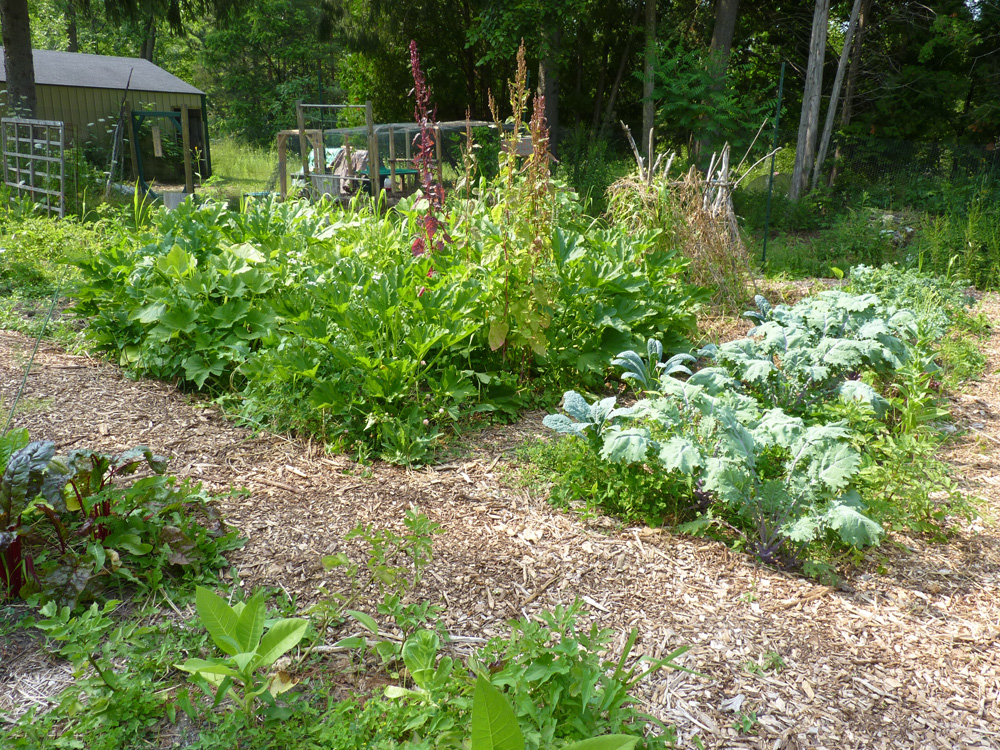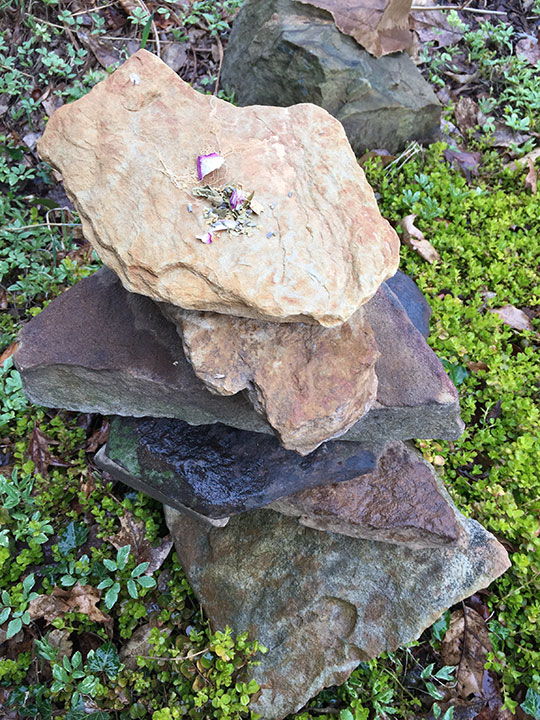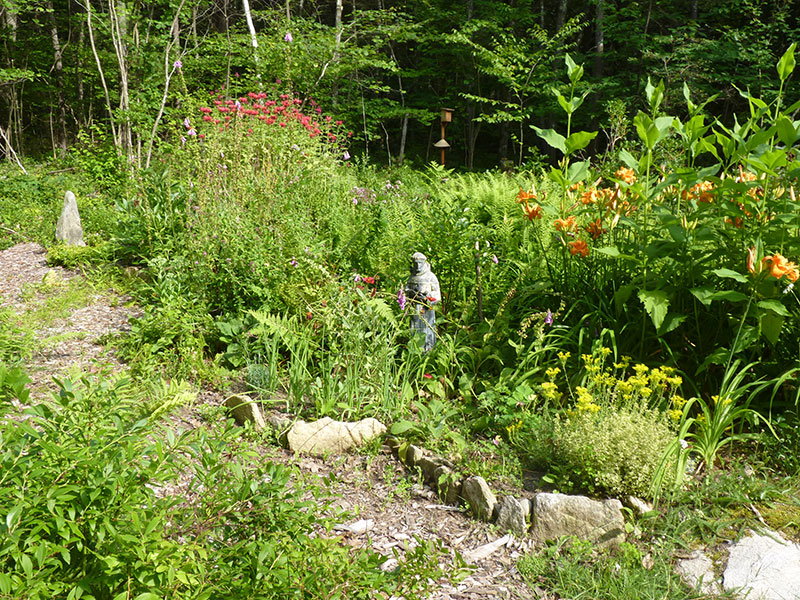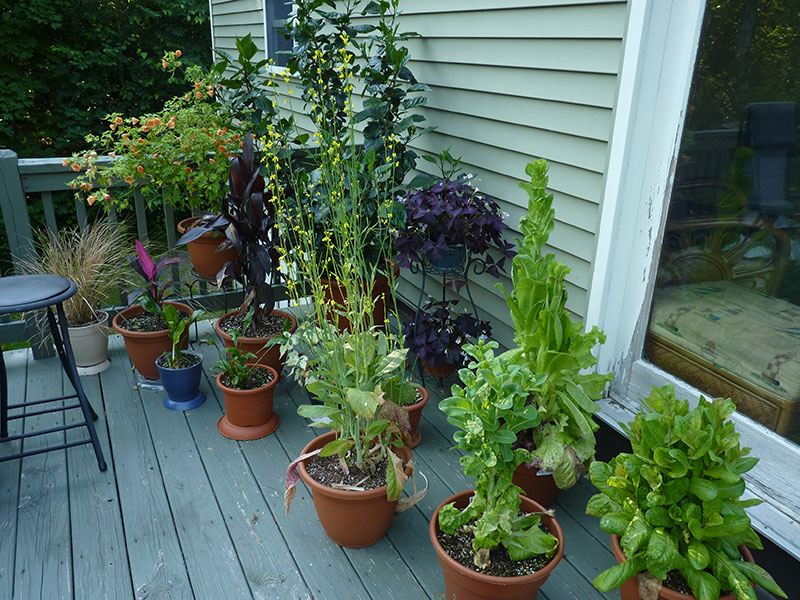
Walking into a sacred garden is like walking into another world, one full of joy, happiness, and wholeness. Fruit hanging from happy branches, plants coming up from all angles inviting a nibble, a taste, a touch. The pathways spiral and you get lost, looking at flowers, breathing in the fresh air, and tasting the tart berries on your tongue. An indoor sacred garden is much the same – a bright window with a chair asking you to sit, stay awhile, and meditate with the plants (or even reach up and take a lemon-scented geranium leaf in your hand and breathe deeply). Sacred gardens are places that are intentionally cultivated to be in harmony and balance, that are carefully tended by loving hands, and that offer many possibilities for spiritual practice and deeper spiritual connection.
It’s amazing to see that this year, so many new people are taking up gardening. While I’ve written on these topics before (obviously, this blog is called the Druid’s Garden!), I’m returning to this topic today to offer an overall philosophy of sacred gardening that I hope can help you deepen your practice or start a new garden. I’ve been engaged in these practices for over a decade, greatly aided by my permaculture design certificate and permaculture teacher training, which offered me much in the way of working with nature and developing deep observation, interaction, and ethical skills. I realize that other authors, especially those coming from different spiritual traditions, may have a very different take. But this is mine :).
Sacred Gardening: A Triad of Reciprocity, Life Honoring, and Connection
To define sacred gardening, let’s start by looking at the definitions for the two terms. A garden refers to a place where ordinary people can grow food. Beyond that, gardens actually vary pretty widely based on the philosophy and practices of a gardener. You can have gardens that are organic and holistically managed or those that are full of chemicals, weed killers, and poisons. You can have gardens that are diverse and support life or those that are focused on keeping all life that isn’t intended out with some pretty violent means. You can have large or small gardens, indoors or out. They can be perennial or annual. Gardens, then, are defined by crowing food, and cultivating plants for human benefit; they are often (but not always) very human-dominated spaces.
Sacred refers to something that is dedicated to a spiritual or religious purpose, something that is deserving veneration, is worthy of awe; and/or something that is entitled to reverence and respect. When we think of something that is sacred, it is a special place where we offer honor, respect, and reverence. Where we tend to our interactions and be intentional in our practices. For thinking about nature as sacred, several concepts emerge that are critically important to our discussion here they are: connection, reciprocity, and honoring life It is in these three concepts that we can arrive at a useful definition of sacred gardening.

Actions here represent the third aspect that is important to define. The ultimate point of most gardening is growing food, using whatever means an individual chooses. What makes gardening sacred is how the gardener chooses to interact with the land, the specific choices and behaviors that the gardener engages in, and the intentions put forth into the space. As with many things, while intentions matter a great deal, it is actions that determine our relationships and reality to the land. You can have all of the sacred intentions in the world, but walking into your garden with a backpack sprayer full of Round-Up sends a very different message.
At the same time as actions speak intentions into the world, it is also important to recognize that the physical and metaphysical are affected by each other and that there are many metaphysical aspects that can affect a physical space and vice versa. Thus, we can think about sacred gardening as being about both inner and outer practices, practices that help not only support the physical presence of the garden but also the spirit.
Thus, I see three guiding principles, a triad in the druidic sense, that can help us with a full definition of this practice:
Three principles for sacred gardening:
Deepening inner and outer connections with the garden
Engaging in reciprocity with the garden
Honoring and creating spaces the diversity of life in the garden
Thus, sacred gardening is a practice of cultivating a space (indoors or outdoors) that allows for not only growing food but also spiritual connection, reciprocity, and honoring life through both inner and outer practices. In the remainder of this post, I’ll explore these three concepts and offer both “inner” (metaphysical) and outer “physical” practices
Connection: Building a Relationship
The first principle is connection. Sacred gardening is connected gardening, where a big part of the goal of sacred gardening is to cultivate a deep relationship with the garden: which might include plants, soil, bird or insect life, stones, and other features. Connection allows us to learn and grow in the garden by building a deeper relationship with that garden. Connection can mean many things in a garden setting, from developing a long-standing relationship with seeds that you carefully harvest and save each year to learning more about your space. So now let’s look at three “inner” and “outer” connection practices.

Inner Connection Practices for sacred gardening. These three practices don’t have to be taken up all at once. I suggest you start with one of them and build to others over time–it can take years to establish deep connections. Think about inner connection work as taking a seasonal approach: each season you can grow and deepen your practice
- Plant Spirit Communication. Learning how to directly communicate with your plants and the spirits of your land is a fantastic way to build deep connection. By practicing and learning these communication techniques, you can learn from nature and grow in deep ways–as plants have been teachers of humans long, long, before recorded history. Many of our garden plants, especially the culinary herbs like rosemary, lemon balm, and sage, have extremely long relationships with humanity and are almost always willing teachers. For more on plant spirit communication techniques, see Plant Spirit Communication 1, Plant Spirit Communication 2, Plant Spirit Communication 3, and Plant Spirit Communication 4.
- Meditation. Meditation techniques, including walking meditation and meditation where you are in stillness within the space, are excellent ways to build connections. Consider doing your regular meditative practices in your garden as often as you can. Even taking 5 or 10 minutes a day in your garden to meditate and connect can be a very positive experience–for you and for the garden!
- Planting and Harvesting Rituals. Relationships are built, in part, by recognizing the spirit in the plants and honoring that spirit. I have found that planting, blessing, and harvesting rituals are a great way to build a spiritual connection between yourself and your garden plants. Here are a few rituals for you to try: land blessing, planting ritual 1, planting ritual 2.
Outer Connection Practices. Outer connection practices help signal to the spirits of the land your intentions. Humans in this age often take the easy and quick ways out (e.g. plowing, pesticides, chemical fertilizers), and those easy and quick ways are often at a high ecological cost. By taking things differently, and slowly, we can demonstrate sacred intent.
- Supporting the soil web and soil health. One critical physical connection in gardens is the soil and building soil health. I would suggest as part of your connection to the garden, you work to attend to your soil–of which there are many different practices. One of the most important is, for outdoor gardens, taking up the practice of no-till gardening, for example, using sheet mulch or hugelkultur approaches. Supporting a healthy soil web begins with avoiding tilling a garden; tilling each year destroys the soil web and is quite destructive on the soil bacteria, nematodes, worms, mycelial networks, and more. Adding rich compost (finished compost, coffee grounds, etc) and natural amendments help cultivate rich soil. Here’s more on a few compost techniques: composting for city dwellers, composting options for outdoors, and vermicompost.
- Observation and interaction. One of the first principles of permaculture design is a very useful one to list here. To build a connection, you have to interact, to be present, and to do so frequently throughout the season. Observe your plants as they grow. Spend time with them, watch how they grow. Look at them at different points in the season and at different times of day. Take a full moon walk and see the glistening of the dew in the early morning. This kind of walking meditative practice, where you are simply present with your garden, will offer you much. More on observation and interaction.
- Seed starting and seed choices. Another connection practice focuses on seeds. Seeds today can be difficult to navigate and choose because of the proliferation of GMO seeds (which I don’t recommend for sacred gardening)–this guide offers some suggestions for seeds. Once you’ve selected some good seeds, you can start some for yourself (even starting a few will really give you a connection with the plant). And I would suggest saving at least some varieties of seed from year to year. For example, I have tobacco seeds that I use for ceremonial purposes and I’ve cultivated a many-year relationship with those seeds. At this point, each time I welcome up the new tobacco, it is greeting an old friend!
Connection allows us to begin to establish deep relationships with our sacred garden both in inner and outer ways. I believe that connection is a basic requirement for sacred gardening–and the other two steps begin with this one. Let’s now turn to the second principle–reciprocity–and see how it leads directly from connection.

Reciprocity: Giving Back
Reciprocity refers to the ongoing relationship that is mutually beneficial where each side continues to gain positive benefits from the relationship. In the case of a sacred garden, abundant land produces yields to sustain you. In the case of the gardener, the gardener does things to improve the diversity and health of the land and ecosystem–not only for the direct benefit of growing food but beyond.
Inner Reciprocation Practices help us to shift our mindset from those commonly assumed and indoctrinated in our culture to something more sacred and reciprocal.
- Offerings and Gratitude. In a sacred garden, whether it is indoors or outdoors, I like to have a space reserved for gratitude and practice gratitude regularly–this is the first step. I usually build some kind of small shrine (whether that is on the windowsill or in a corner of a larger garden) and leave regular offerings. Offerings may be physical, musical, or spiritual (energetic). More on gratitude practices from an earlier post.
- Meditations and critical thinking work. Another good practice here is to spend time dismantling (though discursive meditation or other thought processes) the underlying assumptions about nature that we might not even consciously be aware of. Our present culture has a constant assumption that 1) nature is there for our benefit and profit and 2) we can take from nature heedlessly and constantly. These kinds of assumptions run through everyday life in unexpected ways and it can take some serious work to distance ourselves from them and to develop more healthy and productive beliefs about our relationship with nature. For some good reading on this topic, I highly recommend Wendell Berry’s Unsettling of America: Culture and Agriculture and John Michael Greer’s Mystery Teachings of the LIving Earth.
Outer Reciprocation work helps us create gardens and plans that give back as much (or more) than we take, and establishes balance and harmony with us and the living earth.
- Closed-Loop Systems and replacing what is taken. One of the reasons that chemical fertilizers are so popular is that as we remove nutrients from the soil, they have to be replaced (even so, we know that these kinds of farming techniques have caused a considerable nutritional decline over the decades). Ultimately, the loss of nutrients permanently from the soil is a problem with reciprocation. At minimum, we need to be replacing nutrients that are lost through erosion and harvest–but I’d argue that we need to do one better and add even more than was originally present. Practicing composting is one way, and for more radical folks, humanure and liquid gold offer ways to have a truly closed-loop system. Adding healthy amendments (I especially like to get coffee grounds from nearby coffee shops and interrupt other waste streams to divert to my garden). Gathering up fall leaves and using them as part of your gardening practice is another resource.
- Reduction or Elimination of Fossil Fuel Use. Another issue with reciprocation has to do with our over-dependence on fossil fuels, a dependence upon which is literally killing life on our planet and threatening our very existence as a species. As an act of reciprocation and acknowledgment of the problems with fossil fuel, I make it a point to do as much of my gardening by hand as I possibly can (even in a 1000 square foot garden!). When I must make use of fossil fuels (such as to bring off-site compost to establish new beds), I make sure that I am making minimal and conscious use of these resources.
- Scattering Seeds and Wildtending. As part of the gardens at the Druid’s Garden homestead, we have a “refugia” where grow a number of rare medicinal species and regularly scatter their seeds to wild and untended places, particularly places that have suffered ecological devastation after logging or other disruption (common where we live). We grow both full sun perennials (like St. Johns Wort and New England Aster) as well as shade-loving woodland medicinals (wild ginseng, blue cohosh, black cohosh, ramps, goldenseal, bloodroot). We also make sure to give seeds and seedlings out to others as much as we possibly can. This is a direct response to many of these plants being lost in our local ecosystem and offers one way to give back.
Honoring Life through Sacred Gardening

When you start thinking about connection and reciprocation, this is all leading to the most important sacred principle of all: that of honoring all life. This is tricky–gardens are traditionally human-dominated spaces and the goal is traditionally to grow food for humans. When the potato beetles or squash borers come knocking, “honoring life” is probably the furthest thing from your mind as you literally watch your hard tended squash plants wither and die on the vine. This is when you might be tempted to go to your nearest big box store for a chemical solution. But it is exactly these situations that test us as sacred gardeners, druids, and nature-honoring people. Nature herself has ways of bringing those squash beetles in balance, and there are many things we can do. The principle here of honoring life is so critical because it is this principle that is so broadly lacking.
Inner Principles focus on cultivating a diversity of life principles as part of our gardening practice.
- A full season of blessing rituals. Offering regular rituals in the space that bless and welcome life is a great way over time to affirm your relationship with the sacred garden and raise positive energy for the space. Here’s one such approach based on land healing.
- Inviting others in. One of the ways to honor the life of your garden is by inviting others in, sharing with them, and helping others understand these basic principles. Once you’ve done enough that you have something to share, invite others in to learn, grow, and enjoy the space. I try to do this often, and as I offer a “garden tour” I share not only what is going, but the life-affirming philosophy that is present in the garden space and how we bring that into reality.
- Permaculture ethics. Meditations on the three ethics of permauclture (earth care, people care, and fair share) can really help one develop a mindest that honors life and the resulting behaviors. I like to regularly meditate on these concepts and also create signs for my home that remind me of these concepts.
Outer Principles
- Welcoming the diversity of life – pollinator hedges and more. When designing for spaces and when planning, I think its important to design just not for what we want to eat but to welcome in diversity, particularly insect and amphibian diversity. Insect diversity can help us with integrated pest management (below) but also just with cultivating spaces that have room for life. A simple way to do this, for example, is to use a pollinator hedge–fill it with perennial species like borage, mint, comfrey, sage, milkweed, and more. These pollinator hedges help welcome in insect life into your space and create habitat, food, and forage for non-human life. Another common feature is a small frog pond and bee drinking area; a place for frogs, toads, and other amphibians to lay eggs, shelter from the hot sun, and get a drink. A final thing here to consider is that life-honoring gardens are usually a little more “wild” than their human-dominated counterparts!
- Integrated pest management. There are so many ways to deal with pests naturally. Planting pollinator species, particularly the kinds that attract parasitic wasps, can help you with a host of pest problems. Letting your chickens or ducks run through the garden. Using cayenne pepper or copper tape to address slugs–the list goes on and on. Most garden pests have several natural solutions in the short term. In the long term, fostering a healthy ecosystem allows the predatory species of insects to handle the ones that could cause you trouble. This approach does take more work and knowledge than a chemical one, and you are likely to lose some crops along the way–but in the end, it will be a much more life-respecting and affirming choice.
- Making full use of the harvest. Another aspect of reciprocation is to use fully what is harvested and not contribute to food waste. I think its really important that, in a time where up to 50% of the food grown is wasted, we make every effort to honor what was grown and produced in our gardens. This often means taking up some kind of food preservation, such as canning or drying produce. Another way of thinking about this is also offering the harvest up to other life–e.g. if I can’t eat all my tomatoes, can some of my neighbors or friends enjoy them? What about offering leftovers to my chickens who convert that garden produce into eggs and manure?

Conclusion
I hope these principles will help those of you who are starting gardens with the intent of having sacred gardens or for those of you who already have a gardening practice and want to make it more sacred and intentional. I would love to hear from you in the comments about other ways that you’ve engaged in sacred gardening techniques and things that you do.




Reblogged this on Blue Dragon Journal.
[…] via Introduction to Sacred Gardening: Connection, Reciprocity, and Honoring Life — The Druid’s G… […]
Reblogged this on Rattiesforeverworldpresscom.
Lovely post. My work is focused on knitting together my land community, which has been fragmented by clearing and is now a mix of native and exotic healing pioneer species with a few keystone Elders, and holding the space for a synergistic working to evolve (They usually know more about what They are aiming for overall than I do, of course, but we’re co-creating something which works for all of us). Right now (late autumn in Australia) I’m bringing more of my crack willow trees into a cycle of pollarding and harvesting for fencing materials, and preparing to plant more trees in late winter/spring. Also trying to figure out how to share my Zone One gardens with possums, who come here over winter because it’s the most reliable source of food. It’s the first time I’ve tried growing an annual winter garden and I thought I’d be safe with brassicas as everything I’ve read tells me you’re not supposed to feed them to Australian mammals because it’s bad for them. Unfortunately they don’t read the same books. At the moment, I’m ceding them the space this year (they’ve already broken into the netted areas and eaten everything down to the ground, lol) and instead, I’ll be working on establishing and enclosing more raised beds that are off their radar for future winter crops. And longterm, planting as many winter-bearing food trees for them in Zone 4 as I can find, and considering revegetating the remaining native gully with locally endemic bushfood species, After all, they must have eaten something before my cauliflowers. I’m undecided about what to do with the existing beds in future years though, since they’re a large portion of my annual growing space. A good subject for meditation…
Hmm, I don’t think much of that was actually on topic, but it became clear as I was writing it that I needed to reframe The Possum Question to find a more harmonious way of thinking about their role in my spiritual life as well as my garden, so thank you for providing the space 🙂
Hi Liz,
It’s always nice to think about and share about your garden and growing space :). It sounds like you are finding life-honoring ways of addressing the possum challenge :). I had similar challenges with groundhogs at my last property. Edible wild foods for them definitely helped in the long term! Thanks for your comment and reading! 🙂
Thank you so much for this post, sacred gardening is a very good opportunity for the world
Yes, I totally agree! THank you for reading 🙂
I just wanted to take a moment and let you know that I REALLY love your page!!
Thank you so much! 🙂
This post was absolutely beautiful. thank you.
Thank you, Jenny! And thanks for your comment :).
Love, Love, Love this article and site. May we share this in our free quarterly magazine “Omni Vision?” It would fit perfectly in our “Regenerative Living” section. All links and attributions would be properly included. https://www.theomnifoundation.com/omni-vision-quarterly
Sure, thats fine. You can credit Dana O’Driscoll with the Druid’s Garden :).
Excellent! Thank you Dana!